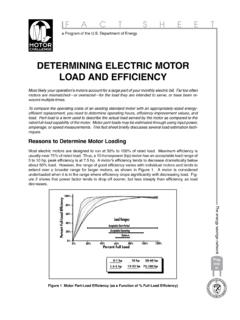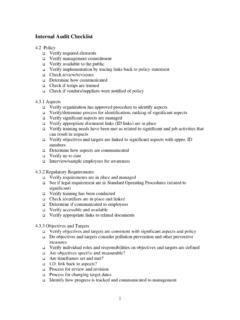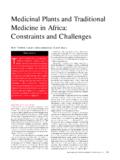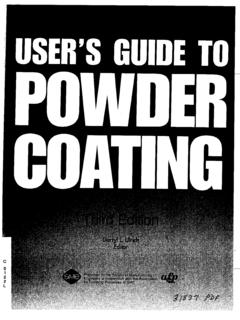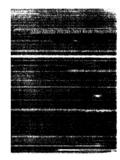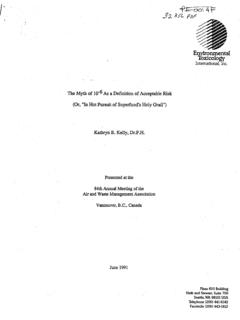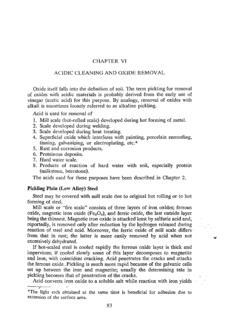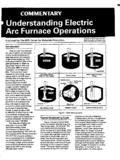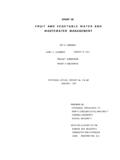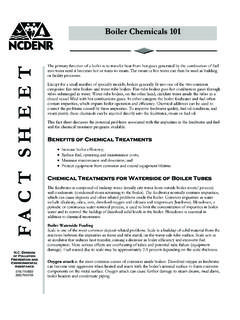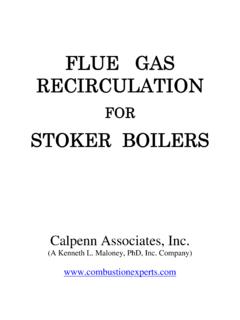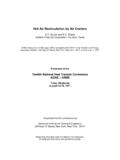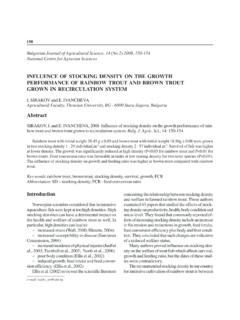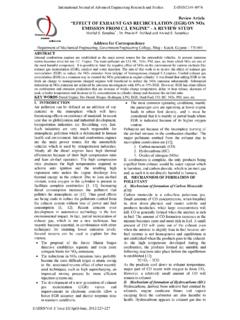Transcription of Paint Booth VOC Emission Reduction Through Air …
1 CoM1-l Paint Booth VOC Emission Reduction -987. Through Air recirculation by Dinesh Bhushan Durr Industries, Inc. , Finishing Systems, Plymouth M I. INTRODUCTION transfer efficiencies. For the surface AIR recirculation . he continued Reduction in allow- coater forced to use solvent based coat- One available method to reduce the T able ,volatile organic compound (VOC) emissions embodied in the ings, the only available option to reduce VOC emissions from spray booths has exhaust volumes from Paint spray booths , while increasing the concentra- Clean Air Act has required operators been the installation of add-on control tion of VOCs in the exhaust stream, is of Paint shops to search for, new equipment to clean the Booth exhaust. air recirculation .
2 This involves recir- methods to limit VOC emissions from Currently available add-on abate- culating most of the exhaust air back their finishing processes. \ ment technologies, such as incineration to the Booth with only a small stream \. Several choices have been available or carbon adsorption, although techni- being drawn off so as to keep the sol- for quite a while, including electrocoat- cally proven, can be prohibitively ex- vent concentration in the recirculating ing, powder coating or the use of very pensive when used for spray Booth stream at any desired level. high solids and even water based spray- VOC control. This is primarily due to Although Booth air recirculation has able coatings; however, for certain ap- the large exhaust streams from Paint been considered a viable method to plications, such as automobile or plas- spray booths with very low concentra- control emissions for a long time, cer- tic surface coating, solvent based coat- tions of VOCs,' which results in a very tain practical problems, particularly ings are still the norm due to the need high capital equipment and running with filtration of particulates, have for very high quality finishes at high cost.
3 Limited its widespread acceptance. Ex- Fig. 1. VOC emissions from automobile spray Booth . I. perience has shown, however, that of VOCs are found in the exhaust from ings so as to prevent solvent vapors careful design of a recirculation system the automatic zones, where most of the from migrating to adjacent manual with a proven fully automatic particu- Paint is applied. With the tendency to- spray zones or into the plant. late removal system can resu!t in a safe wards increased automation in industry and economical system with a signifi- today and the fact that the automatic PRACTICAL CONSIDERATIONS. cant cost advantage over add-on abate- spray zones generally operate at lower FILTRATION: ment equipment to treat 100%of Booth downdraft rates, it is clear that selective A typical high efficiency water exhaust.
4 Abatement of the automatic zones using scrubber, in operation in most high pro- air recirculation will yield the maxi- duction spray booths , is capable of mum Reduction in VOC emissions from overall particulate removal efficiencies Paint Booth emissions a Booth for the smallest investment. exceeding 95%. Chan et a12 have Most high production Paint spray By recirculating the exhaust air from shown that although the efficiency can booths with significant emissions of an automatic zone with only a small exceed 99% for particles above five mi- VOCs are either multi zone booths with bleed stream being exhausted, the sol- crons in diameter, it decreases sharply dedicated zones for manual and auto- vent Concentration in the automatic for partiFles below two microns.
5 Since matic Paint application or single-zone, zone recirculating air stream, as well the high atomization pressures used in fully automatic booths . In either case, as in the exhaust stream, can be raised automatic spray equipment generally the Paint overspray and evaporating considerably. Since the spray Booth is result in these finer Paint particle sizes, solvents are carried out in the exhaust unmanned, this increased solvent level it is clear that additional filtration is air Through a water scrubber to remove does not affect the painting operations necessary before the exhaust air from most of theparticulates. Figure 1shows as long as the solvent concentration an automatic spray zone can be recircu- the concentration of solvents (VOC) in does not increase to the point where it lated.
6 In fact, it is this need for addi- the exhaust air after the scrubber from affects the quality of the Paint job. It tional filtration of the air that has the different zones of a typical automo- should be noted that the automatic limited the widespread application of tive color spray Booth . spray zone should be designed with air recirculation for VOC control until Clearly, the highest concentrations adequate infiltration Through all open- now. Dry Filtration: Much data is available on the use of dry filter banks for secondary air filtra- tion of spray Booth air. Most spray booths currently using carbon adsorp- tion for VOC control use several stages . of dry filtration to remove particulates kin the sub micron to two microh range which would otherwise be deposited on the activated carbon.
7 The main drawbacks of dry filter banks are excessive pressure drop, high maintenance costs due to the frequent filter replacement required and the need for disposal of the Paint laden filters. In addition, the constantly changing pressure drop across the banks of filters as they load up creates problems with Booth balance, unless expensive vari- able frequency drives or volume control dampers are used in the system. Wet ESP: The search for a solution to the prob- lems of dry filtration led to the joint development of a wet electrostatic pre- cipitator (ESP) to remove Paint parti- cles, primarily in the submicron to three micron range, from Booth exhaust air. Figure 2 shows the basic schematic of a wet ESP installed on a base coat automatic spray zone at a passenger car plant in West Germany.
8 The precipita- tor consists of positively charged col- Fig. 2. Wet ESP for Paint from spray Booth exhaust air. lector plates which are grounded to- = * f .. I COMPLIANCE COATINGS. S. I1. r f, S. e 1. Y. 1. f Y. 5. 1. Fig. 3. Particulate removal efficiency of a wet ESP as a function of particle size. 3. i F. gether with the housing, negatibely to air recirculation . Two units are cur- If the mass of solvent introduced into - I. charged stretched wire emitting eke- rently operating on passenger car pro- the system is known, the concentration trodes, high voltage power supply ahd duction booths , with a third unit sched- of solvent in the recirculating stream integral water recirculation systeni. uled for start up in the near future in and the exhaust stream is simply: High dc voltage applied between the Canada.
9 C =M/v F electrodes produces corona discharges It should be noted that although the Where c = Solvent concentration, g/m3. in the immediate vicinity of the emit- wet ESP proves to be the ideal solution M = Solvent used, g/hr I. ting electrodes freeing electrons. The for secondary particulate filtration of V = Exhaust air volume, m3/hr resulting negatively charged gas ions spray Booth exhaust air, the physical , B deposit on the Paint solids in the incom- size of an ESP and the high capital cost Therefore, by assuming a safe maxi- , ing stream, which then migrate to the of the unit mean that it is not always mum value for M, the system may be collector plates. The precipitated parti- the ideal choice for all applications. designed for any solvent concentration L cles are rinsed off the collector plates A wet ESP is generally cost effective desired.
10 By a steady film of water and carried when used for secondary filtration on Experience has shown that a concen- out with the water discharge to a hold- larger exhaust volumes, and particu- tration of 25% LEL (as required by I ing tank where the particulates are re- larly on older spray booths with water most safety and insurance authoritie~)~. moved continuously. scrubbers that are not as efficient as is too high for most high quality finish- 1 The separation efficiency of an ESP modem Booth scrubbers. A wet ESP is ing operations such as automotive top- is given by the Deutsch formula: also suitable for filtration on booths coat application. Although actual con- u = 1 - e-fw where high solids enamel paints are centrations will vary depending on the applied, since these paints, unlike air type of Paint being applied, a concen- I where f is a geometric factor containing dry lacquers, remain tacky for an ex- tration of approximately 5 to 10% has the length of the field, electrode spac- tended period of time, and would sub- proven to be a good design value for ing and air velocity, and w is the mi- stantially increase the cost of maintain- almost any application.
